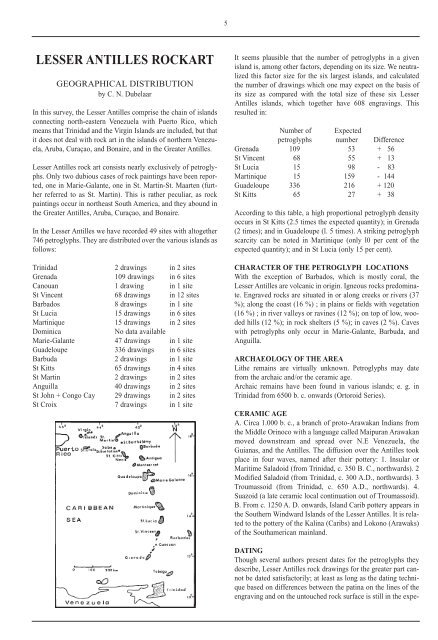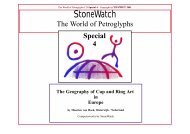petroglyphen im valle del encanto - StoneWatch
petroglyphen im valle del encanto - StoneWatch
petroglyphen im valle del encanto - StoneWatch
Erfolgreiche ePaper selbst erstellen
Machen Sie aus Ihren PDF Publikationen ein blätterbares Flipbook mit unserer einzigartigen Google optimierten e-Paper Software.
LESSER ANTILLES ROCKART<br />
GEOGRAPHICAL DISTRIBUTION<br />
by C. N. Dubelaar<br />
In this survey, the Lesser Antilles comprise the chain of islands<br />
connecting north-eastern Venezuela with Puerto Rico, which<br />
means that Trinidad and the Virgin Islands are included, but that<br />
it does not deal with rock art in the islands of northern Venezuela,<br />
Aruba, Curaçao, and Bonaire, and in the Greater Antilles.<br />
Lesser Antilles rock art consists nearly exclusively of petroglyphs.<br />
Only two dubious cases of rock paintings have been reported,<br />
one in Marie-Galante, one in St. Martin-St. Maarten (further<br />
referred to as St. Martin). This is rather peculiar, as rock<br />
paintings occur in northeast South America, and they abound in<br />
the Greater Antilles, Aruba, Curaçao, and Bonaire.<br />
In the Lesser Antilles we have recorded 49 sites with altogether<br />
746 petroglyphs. They are distributed over the various islands as<br />
follows:<br />
Trinidad 2 drawings in 2 sites<br />
Grenada 109 drawings in 6 sites<br />
Canouan 1 drawing in 1 site<br />
St Vincent 68 drawings in 12 sites<br />
Barbados 8 drawings in 1 site<br />
St Lucia 15 drawings in 6 sites<br />
Martinique 15 drawings in 2 sites<br />
Dominica No data available<br />
Marie-Galante 47 drawings in 1 site<br />
Gua<strong>del</strong>oupe 336 drawings in 6 sites<br />
Barbuda 2 drawings in 1 site<br />
St Kitts 65 drawings in 4 sites<br />
St Martin 2 drawings in 2 sites<br />
Anguilla 40 drawings in 2 sites<br />
St John + Congo Cay 29 drawings in 2 sites<br />
St Croix 7 drawings in 1 site<br />
5<br />
It seems plausible that the number of petroglyphs in a given<br />
island is, among other factors, depending on its size. We neutralized<br />
this factor size for the six largest islands, and calculated<br />
the number of drawings which one may expect on the basis of<br />
its size as compared with the total size of these six Lesser<br />
Antilles islands, which together have 608 engravings. This<br />
resulted in:<br />
Number of Expected<br />
petroglyphs number Difference<br />
Grenada 109 53 + 56<br />
St Vincent 68 55 + 13<br />
St Lucia 15 98 - 83<br />
Martinique 15 159 - 144<br />
Gua<strong>del</strong>oupe 336 216 + 120<br />
St Kitts 65 27 + 38<br />
According to this table, a high proportional petroglyph density<br />
occurs in St Kitts (2.5 t<strong>im</strong>es the expected quantity); in Grenada<br />
(2 t<strong>im</strong>es); and in Gua<strong>del</strong>oupe (l. 5 t<strong>im</strong>es). A striking petroglyph<br />
scarcity can be noted in Martinique (only l0 per cent of the<br />
expected quantity); and in St Lucia (only 15 per cent).<br />
CHARACTER OF THE PETROGLYPH LOCATIONS<br />
With the exception of Barbados, which is mostly coral, the<br />
Lesser Antilles are volcanic in origin. Igneous rocks predominate.<br />
Engraved rocks are situated in or along creeks or rivers (37<br />
%); along the coast (16 %) ; in plains or fields with vegetation<br />
(16 %) ; in river <strong>valle</strong>ys or ravines (12 %); on top of low, wooded<br />
hills (12 %); in rock shelters (5 %); in caves (2 %). Caves<br />
with petroglyphs only occur in Marie-Galante, Barbuda, and<br />
Anguilla.<br />
ARCHAEOLOGY OF THE AREA<br />
Lithe remains are virtually unknown. Petroglyphs may date<br />
from the archaic and/or the ceramic age.<br />
Archaic remains have been found in various islands; e. g. in<br />
Trinidad from 6500 b. c. onwards (Ortoroid Series).<br />
CERAMIC AGE<br />
A. Circa 1.000 b. c., a branch of proto-Arawakan Indians from<br />
the Middle Orinoco with a language called Maipuran Arawakan<br />
moved downstream and spread over N.E Venezuela, the<br />
Guianas, and the Antilles. The diffusion over the Antilles took<br />
place in four waves, named after their pottery: 1. Insular or<br />
Marit<strong>im</strong>e Saladoid (from Trinidad, c. 350 B. C., northwards). 2<br />
Modified Saladoid (from Trinidad, c. 300 A.D., northwards). 3<br />
Troumassoid (from Trinidad, c. 650 A.D., northwards). 4.<br />
Suazoid (a late ceramic local continuation out of Troumassoid).<br />
B. From c. 1250 A. D. onwards, Island Carib pottery appears in<br />
the Southern Windward Islands of the Lesser Antilles. It is related<br />
to the pottery of the Kalina (Caribs) and Lokono (Arawaks)<br />
of the Southamerican mainland.<br />
DATING<br />
Though several authors present dates for the petroglyphs they<br />
describe, Lesser Antilles rock drawings for the greater part cannot<br />
be dated satisfactorily; at least as long as the dating technique<br />
based on differences between the patina on the lines of the<br />
engraving and on the untouched rock surface is still in the expe-
















